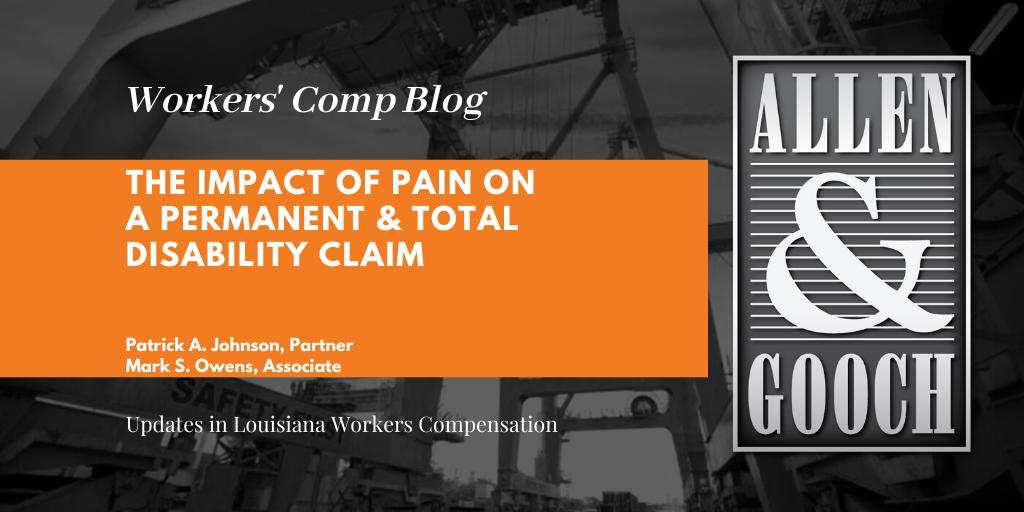Prior to the 1983 amendments to the Workers’ Compensation statute, pain played a large role in permanent and total disability claims. For example, the 1980 Louisiana Supreme Court in Whitaker v. Church’s Fried Chicken, Inc. presented an injured janitor that burned his legs with hot grease, causing severe pain. The court found the claimant to be permanently and total disabled since he could only work in substantial pain and discomfort. The court went so far as holding that a “finding of substantial pain requires that plaintiff be held disabled.”
Today, Louisiana Revised Statute 23:1221(2)(c) provides that “compensation for permanent total disability shall be awarded only if the employee proves by clear and convincing evidence, unaided by any presumption of disability, that the employee is physically unable to engage in any employment or self-employment, regardless of the nature or character of the employment or self-employment, including, but not limited to, any and all odd-lot employment, sheltered employment, or employment while working in any pain, notwithstanding the location or availability of any such employment or self-employment.”
The Louisiana Supreme Court in Comeaux v. City of Crowley held that an injured worker is totally and permanently disabled upon a consideration of a number of factors, including the claimant’s “access to employment, physical factors, age, race, literacy, and experience… [reliance] solely on physical factors is too restrictive.” Of note, the claimant’s treating physician in Comeaux opined that the claimant was in constant unrelenting pain due to his injuries.
Louisiana revised statute 23:1221(2)(c) is fairly straightforward and it is universally understood that permanent and total disability benefits are awarded when a claimant is able to prove, through an objective quality of the evidence presented, that the compensable workplace injury has rendered the claimant physically unable to engage in employment. The emphasis is no longer on whether the claimant remains in substantial pain.
The following cases highlight the difference between the claimant who is permanently and totally disabled…and the claimant that must work through pain.
In Wool v. Jefferson Parish, the claimant worked as a heavy equipment operator and injured his left knee while descending a bulldozer. The injury prevented the claimant from physically being able to continue his employment as an operator. As the Court noted, however, “there [were other] jobs available which he [could] perform without substantial pain.” As such, the Court of Appeal, Fourth Circuit found the claimant was not permanently and totally disabled even after concluding that the claimant had a below-average IQ and only progressed to the seventh grade in grammar school.
This principle that pain, and pain alone, was insufficient to support a finding that a claimant was permanently and totally disabled was echoed by the Court of Appeal, Fourth Circuit in Gardache v. City of New Orleans and again in Degrasse v. Elevating Boats, Inc.
The Court of Appeal, Third Circuit in Smith v. Union Underwear, Inc., held that a claimant can be deemed permanently and totally disabled based solely on his/her pain if in fact the pain is “so substantial that the [claimant] is precluded from engaging in any type of work whatsoever.” The Court made clear, however, that the pain contemplated cannot be “residual or merely a discomfort.” The claimant in Smith was unable to return to her former job due to her pain, but nonetheless was physically capable of performing work that was sedentary in nature. As such, the claimant was not entitled to permanent and total disability benefits.
In a more recent case, the Court of Appeal, First Circuit in Poole v. Guy Hopkins Construction Co., highlighted the importance for a claimant to prove that he/she is unable to engage in any type of employment, which fact must be proven through clear and convincing evidence. As the Poole court illustrated, the clear and convincing evidence standard requires a party to prove that the “existence of a contested fact is highly probable, or much more probable than its nonexistence.” The claimant in Poole argued that he was permanently and totally disabled based on his injuries and the fact he could not be rehabilitated due to his age, level of education, and dependence on narcotic medication. Notwithstanding his injury, the trial court determined that the claimant failed to present any evidence that he attempted to secure any type of employment, which fact the appellate court considered in its finding that the permanent and total disability benefits were not owed.
As the foregoing cases illustrate, Louisiana’s former “working in pain jurisprudence” that guided the court system until 1983 is no more. Louisiana courts are now reluctant to deem a claimant permanently and totally disabled simply because the pain associated with the injury at issue is substantial.
Allen & Gooch is providing this legal update for informational purposes only. This article should not be construed as legal advice or a legal opinion as to any specific facts or circumstances. You should consult your own attorney concerning your particular situation and any specific legal questions you may have.


